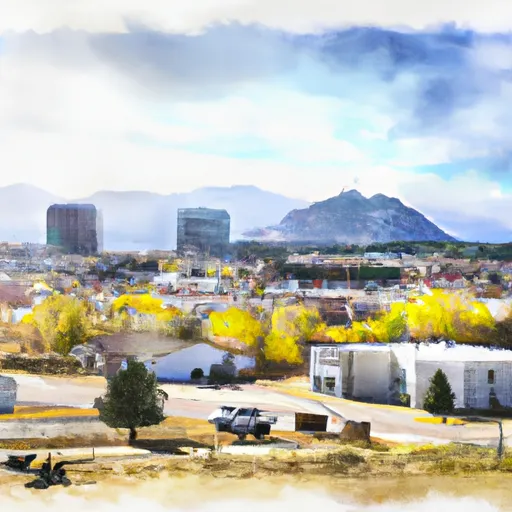-
 Snoflo Premium
Snoflo Premium
Get unlimited access to all our content
With no Ad interruptions! - Start Your Free Trial Login with existing account
Yellow-Jacket
Eden Index
Climate
8.6
•
Recreation
5.8
•
Community
•
Safeguard
5.5/10

Yellow-Jacket, Colorado is a small town located in Montezuma County, in the southwestern part of the state. It experiences a semi-arid climate, characterized by hot summers and cold winters. Average summer temperatures range from the mid-80s to low 90s Fahrenheit, and winter temperatures can drop to the 20s and 30s Fahrenheit. Precipitation is limited, with most rainfall occurring during the summer months.
The hydrology of Yellow-Jacket is influenced by the nearby Dolores River, which flows through the region. The river provides a valuable water source for irrigation and supports diverse aquatic life. Additionally, there are several small creeks and reservoirs in the area that offer recreational opportunities such as fishing and boating.
Outdoor enthusiasts will find ample opportunities for recreation in Yellow-Jacket. The region is surrounded by stunning natural landscapes, including mesas, canyons, and mountains. This makes it an ideal location for hiking, mountain biking, and exploring the great outdoors. Hunting is another popular activity, with an abundance of game species in the area. Furthermore, the Dolores River offers fantastic opportunities for rafting and kayaking, attracting adventure seekers from far and wide.
In conclusion, Yellow-Jacket, Colorado offers a semi-arid climate, with hot summers and cold winters. Its hydrology is shaped by the Dolores River, providing water resources and recreational opportunities. The region's natural beauty and diverse terrain make it a haven for outdoor enthusiasts, offering a range of activities such as hiking, mountain biking, hunting, and water sports.
What is the Eden Index?
The Snoflo Eden Index serves as a comprehensive rating system for regions, evaluating their desirability through a holistic assessment of climate health, outdoor recreation opportunities, and natural disaster risk, acknowledging the profound impact of these factors on livability and well-being.
Climate Health Indicator (CHI): 8.6
Yellow-Jacket receives approximately
385mm of rain per year,
with humidity levels near 63%
and air temperatures averaging around
10°C.
Yellow-Jacket has a plant hardyness factor of
6, meaning
plants and agriculture in this region thrive during a short period during spring and early summer. Most
plants will die off during the colder winter months.
By considering the ideal temperature range, reliable water supplies, clean air, and stable seasonal rain or snowpacks, the Climate Health Indicator (CHI) underscores the significance of a healthy climate as the foundation for quality living.
A healthy climate is paramount for ensuring a high quality of life and livability in a region, fostering both physical well-being and environmental harmony. This can be characterized by ideal temperatures, reliable access to water supplies, clean air, and consistent seasonal rain or snowpacks.
Weather Forecast
Streamflow Conditions
Lower San Juan
Area Rivers
Lower San Juan
Snowpack Depths
Lower San Juan
Reservoir Storage Capacity
Lower San Juan
Groundwater Levels
Recreational Opportunity Index (ROI): 5.8
The Recreational Opportunity Index (ROI) recognizes the value of outdoor recreational options, such as parks, hiking trails, camping sites, and fishing spots, while acknowledging that climate plays a pivotal role in ensuring the comfort and consistency of these experiences.
Access to outdoor recreational opportunities, encompassing activities such as parks, hiking, camping, and fishing, is crucial for overall well-being, and the climate plays a pivotal role in enabling and enhancing these experiences, ensuring that individuals can engage in nature-based activities comfortably and consistently.
Camping Areas
| Campground | Campsites | Reservations | Toilets | Showers | Elevation |
|---|---|---|---|---|---|
| Mountain Sheep Point Dispersed | None | 6,091 ft | |||
| Cabin Canyon | 11 | 6,518 ft | |||
| Bradfield | 22 | 6,474 ft | |||
| Ferris Canyon | 7 | 6,566 ft |
Nearby Fishing
Catastrophe Safeguard Index (CSI):
The Catastrophe Safeguard Index (CSI) recognizes that natural disaster risk, encompassing floods, fires, hurricanes, and tornadoes, can drastically affect safety and the overall appeal of an area.
The level of natural disaster risk in a region significantly affects safety and the overall livability, with climate change amplifying these risks by potentially increasing the frequency and intensity of events like floods, fires, hurricanes, and tornadoes, thereby posing substantial challenges to community resilience and well-being.
Community Resilience Indicator (CRI):
The Community Resilience Indicator (CRI) recognizes that education, healthcare, and socioeconomics are crucial to the well-being of a region. The CRI acknowledges the profound impact of these elements on residents' overall quality of life. By evaluating educational resources, healthcare accessibility, and economic inclusivity, the index captures the essential aspects that contribute to a thriving community, fostering resident satisfaction, equity, and social cohesion.

